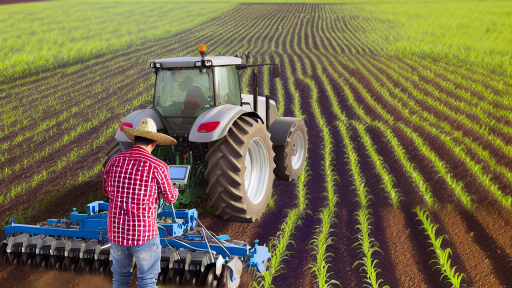Understanding Farm Subsidies: Types and Purposes
What Are Farm Subsidies?
Farm subsidies are financial aids provided by the government.
These aids support agricultural producers to stabilize the food supply.
Additionally, they aim to improve farmers’ income and preserve rural communities.
Types of Farm Subsidies
There are several types of farm subsidies available today.
Direct payments are a common form of support.
These payments go directly to farmers based on their production choices.
Another type is price supports, which guarantee a minimum selling price.
These supports help maintain income levels for various commodities.
Additionally, there are conservation subsidies that encourage sustainable practices.
These subsidies aim to protect natural resources and promote biodiversity.
Purpose of Farm Subsidies
The primary purpose of farm subsidies is to ensure food security.
They help stabilize the agricultural sector during fluctuating markets.
Furthermore, they encourage sustainable farming practices over time.
Subsidies also aim to support rural economies and employment.
Finally, they can enhance farmers’ resilience to climate change challenges.
Transform Your Agribusiness
Unlock your farm's potential with expert advice tailored to your needs. Get actionable steps that drive real results.
Get StartedResearching Available Subsidies
Understanding Federal Programs
Federal programs offer significant financial support for farmers.
The United States Department of Agriculture (USDA) manages these initiatives.
Programs include direct payments and crop insurance options.
Farmers must frequently check the USDA website for updates.
Additionally, they can visit local USDA offices for personalized assistance.
Exploring State Programs
Each state has unique agricultural subsidy programs.
These programs often address specific local needs and conditions.
Farmers should contact their state’s agriculture department for details.
Moreover, many states provide educational resources on subsidies.
State programs can vary significantly in funding and eligibility criteria.
Discovering Local Initiatives
Local governments may offer additional funding opportunities.
These opportunities may focus on community-supported agriculture.
Farmers should network with local agricultural organizations.
Community meetings often provide insights into available subsidies.
Furthermore, collaborations with local universities can prove beneficial.
Identifying Specific Eligibility Criteria
Each subsidy program has distinct eligibility requirements.
Potential applicants must review these requirements closely.
Federal, state, and local programs may vary in criteria.
Understanding these differences is crucial for a successful application.
Farmers can often find this information on program websites.
Staying Informed on Changes
Subsidy programs frequently undergo revisions and updates.
Farmers need to subscribe to newsletters or notifications.
Following relevant social media channels can also provide timely updates.
Maintaining communication with agricultural advisors is beneficial.
Showcase Your Farming Business
Publish your professional farming services profile on our blog for a one-time fee of $200 and reach a dedicated audience of farmers and agribusiness owners.
Publish Your ProfileAdapting quickly to changes can improve funding opportunities.
Eligibility Criteria
Assessing Your Farm’s Qualifications
Applying for farm subsidies requires meeting specific eligibility criteria.
First, evaluate the type of farming you engage in.
Common categories include crop production, livestock, and aquaculture.
Next, determine your farm’s size and production capacity.
Subsidy programs often have size requirements that vary by initiative.
Additionally, assess your farm’s income level.
Many subsidies target farmers with limited financial resources.
Moreover, consider your location and the regional programs available.
Programs tailored to specific geographic areas often have distinct requirements.
Documentation Requirements
Gather necessary documents to prove eligibility efficiently.
Start with your farm’s business registration paperwork.
Also, prepare tax returns from the previous years.
Ensure you have records of income and expenses readily available.
Incorporate proof of land ownership or leasing agreements.
Lastly, compile any certifications or licenses applicable to your farming practices.
Understanding Specific Programs
Research the various subsidy programs available in your area.
For example, the Farm Service Agency (FSA) offers multiple programs.
Each program may have distinct criteria and objectives.
Therefore, read the guidelines carefully to understand requirements.
Additionally, local agricultural extension offices can provide insights.
They often have resources tailored to your specific region.
Consulting Professionals
Consider seeking professional assistance for your subsidy application.
Agricultural consultants can offer expertise in navigating the process.
They help ensure you meet all the necessary requirements.
Furthermore, specialists can assist with accurate document preparation.
Networking with other farmers may provide valuable insights as well.
Sharing experiences can facilitate a smoother application process.
Uncover the Details: Common Mistakes When Applying for Farm Aid
Gathering Required Documentation
Understanding Documentation Needs
Applying for farm subsidies requires thorough documentation.
It is crucial to know the specific documents needed for your application.
Start by checking the requirements set by your local agricultural office.
They will provide detailed information on necessary documentation.
Essential Documents
Gather the following essential documents for your application:
- Proof of identity such as a driver’s license or passport.
- Farm business registration details or tax identification number.
- Financial statements including balance sheets and income statements.
- Historical production records to demonstrate previous yields.
- Maps or descriptions of your farm layout and crops grown.
Additional Supporting Materials
In addition to essential documents, consider including supporting materials.
These materials help establish your eligibility for subsidies.
Examples include soil test results or environmental impact assessments.
Moreover, letters of recommendation from local agricultural organizations can be beneficial.
Organizing Your Documentation
Organize your documentation systematically before submission.
Use folders or digital files for easy access and reference.
Showcase Your Farming Business
Publish your professional farming services profile on our blog for a one-time fee of $200 and reach a dedicated audience of farmers and agribusiness owners.
Publish Your ProfileLabel each document clearly for quick identification.
This organization will help during the review process.
Review and Finalization
Before submitting your application, review all documents carefully.
Check for completeness and accuracy in all provided information.
Consider having a peer or advisor review your application as well.
Finally, ensure that all documents are signed and dated when required.
Discover More: Financial Assistance Resources for New Farmers
Filling Out Subsidy Applications: Step-by-Step Guide
Understanding the Application Process
Begin by familiarizing yourself with the application process.
Each subsidy program has specific guidelines to follow.
Gather information regarding eligibility requirements.
Locate the official website for the subsidy you wish to apply for.
Review the details thoroughly before starting your application.
Preparing Necessary Documentation
Collect all required documents before filling out the application.
This may include financial statements, tax returns, and business plans.
Make copies of all documents for your records.
Ensure all information is up-to-date and accurate.
Having these documents ready will streamline the application process.
Completing the Application Form
Start filling out the application form once prepared.
Provide complete and accurate information in each section.
Double-check for any spelling or numerical errors.
Use clear and concise language throughout the application.
Follow the instructions carefully to avoid disqualification.
Reviewing Your Application
Once completed, review your application thoroughly.
Check for any missing information or documentation.
Consider having a colleague review your application for clarity.
Make any necessary adjustments based on feedback received.
Completing this step will help increase your chances of approval.
Submitting the Application
Submit your application before the deadline.
Ensure you have selected the correct submission method.
Keep a copy of the application and any confirmation received.
Monitoring the submission process is essential.
Follow up if necessary to ensure your application was received.
Waiting for Approval
After submission, you will need to wait for a response.
Be patient, as the review process may take time.
Utilize this time to prepare for any potential follow-up questions.
Stay informed about the status by checking designated channels.
Be ready to provide additional information if requested.
Uncover the Details: Comparing Different Farm Subsidy Programs

Common Mistakes to Avoid When Applying for Subsidies
Failing to Research Eligibility
Many applicants overlook research on subsidy eligibility requirements.
Understanding specific criteria is essential for success.
Showcase Your Farming Business
Publish your professional farming services profile on our blog for a one-time fee of $200 and reach a dedicated audience of farmers and agribusiness owners.
Publish Your ProfileNot all farms qualify for all types of subsidies.
Take time to learn about state and federal programs.
This effort can prevent wasted time and resources.
Inaccurate or Incomplete Documentation
Applicants often submit forms with inaccuracies or missing information.
Double-check all entries before submission.
Ensure supporting documents are complete and properly formatted.
Lack of accurate documentation can lead to application denial.
Take the extra step to confirm all details are correct.
Ignoring Deadlines
Missing application deadlines is a common oversight.
Keep track of all important dates related to subsidies.
Set reminders to submit applications well in advance.
Staying organized can significantly enhance your chances.
Not Seeking Professional Help
Many farmers hesitate to seek assistance from professionals.
Consulting with experts can provide valuable insights.
Advisors can help navigate complex rules and regulations.
Utilizing resources like agricultural extension offices is a wise choice.
Professional help often leads to more successful applications.
Overlooking Follow-Up Procedures
After submission, some applicants forget to follow up.
Check the status of your application regularly.
Inquire about any additional required information promptly.
Following up demonstrates your commitment to the process.
It can also clarify any pending issues that might arise.
Find Out More: Steps to Secure Financial Aid for Your Farm
Tips for Presenting Your Case
Understanding Your Audience
Identify who will review your application.
Consider their interests and priorities.
Tailor your application to address these aspects.
Use language that resonates with them.
Gathering Required Information
Collect all necessary documents ahead of time.
Include tax records and previous financial statements.
Provide information on crop yields and farming operations.
Ensure all data is current and accurate.
Writing a Compelling Narrative
Tell your story clearly and concisely.
Highlight your passion for farming and sustainability.
Include challenges you’ve faced and how you overcame them.
Use specific examples to illustrate your points.
Emphasizing Your Impact
Describe how the subsidies will benefit your farm.
Focus on the positive effects on the local community.
Explain how your farming practices enhance sustainability.
Share projected outcomes and future plans.
Editing and Reviewing
Revisit your draft multiple times for clarity.
Showcase Your Farming Business
Publish your professional farming services profile on our blog for a one-time fee of $200 and reach a dedicated audience of farmers and agribusiness owners.
Publish Your ProfileCheck for grammatical errors and typos.
Ask for feedback from peers or mentors.
Make revisions based on constructive criticism.
Submitting Your Application
Ensure you meet all submission deadlines.
Double-check that all documents are complete.
Confirm that you have followed application guidelines.
Maintain copies of everything for your records.
Following Up: What to Do After Submitting Your Application
Confirm Submission
First, verify that your application was successfully submitted.
Check for an email confirmation from the funding agency.
If you received no confirmation, follow up directly with the agency.
Set a Timeline for Follow-Up
Establish a schedule to track your application’s progress.
Typically, agencies provide a timeline for decision-making.
Mark key dates on your calendar for reminders.
Maintain Communication
Keep communication lines open between you and the agency.
Contact them periodically to inquire about your application status.
Be polite and professional in your communications.
Prepare for Possible Requests
Anticipate the need for additional documentation or information.
Have your records organized and easily accessible.
This preparation shows your commitment to the process.
Stay Informed About Funding Opportunities
Regularly check for updates on funding opportunities.
Follow relevant news and announcements from agricultural agencies.
Networking with fellow farmers can also provide insights.
Plan for Both Outcomes
Prepare for any outcome of your application submission.
Consider how you’ll proceed if approved or denied.
Having a plan B can help you stay focused on your goals.
Additional Resources
Agricultural Subsidies | National Agricultural Library
House Agriculture Committee Completes Markup of 2024 Farm Bill …




